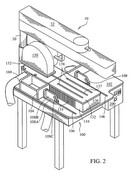
Michael Powell’s invention is fairly simple – it covers a guard for a circular saw on an arm. In 2004, Mr. Powell developed the guard and provided several prototypes to Home Depot for the company to use in its in-store saws for cutting raw lumber to customer specifications. Rather than having Powell manufacture the guards, Home Depot turned to another company for its 2,000 stores. Powell obtained a patent then sued Home Depot. After a three-week trial, a Florida jury awarded Powell $15 million in damages. The district court also awarded enhanced damages, attorney fees, and pre-judgment interest — bringing the total to $24 million.
On appeal, the Federal Circuit affirmed claim construction, infringement, willfulness, inequitable conduct, and damages. Dissenting-in-part, Judge Dyk argued only that the finding of willful infringement was incorrect because Powell did not prove that Home Depot’s non-infringement defense was objectively unreasonable as is required under the objective prong of the willfulness inquiry.
Inequitable Conduct: One interesting element of the appeal involved inequitable conduct. During prosecution, Powell had filed a Petition to Make Special on grounds that he was obligated to manufacture and supply devices embodying the claims sought. MPEP 708.02. That original petition was roughly correct based upon ongoing manufacturing negotiations with Home Depot. Although negotiations with Home Depot fell-through before the PTO granted the petition, Powell never informed the PTO that he no longer qualified for the Special designation under the prospective manufacture prong and actively encouraged the PTO to decide the petition.
In a pre-Therasense decision, the district court held that the failure to inform the PTO was done with intent to deceive the PTO, but that the intentional omission was not material because (1) the timing was not related to patentability and (2) Powell could have instead filed a petition to make special based upon ongoing infringement of the applied-for claims. Under Therasense, inequitable conduct will not normally be found based upon an applicant’s improper omission unless the omission is the but-for cause of the patent being issued.
On appeal, the Federal Circuit affirmed — holding that:
Where, as here, the patent applicant fails to update the record to inform the PTO that the circumstances which support a Petition to Make Special no longer exist—that conduct does not constitute inequitable conduct. That is so because Mr. Powell’s conduct obviously fails the but-for materiality standard [of Therasense] and is not the type of unequivocal act, “such as the filing of an unmistakably false affidavit,” that would rise to the level of “affirmative egregious misconduct. Id.
This case creates further difficulty for patent attorneys by giving a free-pass to patent applicants who intentionally deceive the PTO in order to benefit their case. Although participating in such activity violates the rules of conduct for patent law professionals under 37 C.F.R. 10.22, patent owners apparently will not face consequences. Adding to the incentive for bad behaviour is the PTO’s lax enforcement through the Office of Enrollment and Discipline; the new statute of limitations on attorney misconduct charges; and the new supplemental examination procedures that allows patentees to whitewash patents obtained through inequitable conduct. For some this may not be intuitive, but the primary solution is not increased enforcement but instead for the PTO to avoid relying upon attorney statements.

 Nilssen v. Osram Sylvania (
Nilssen v. Osram Sylvania (